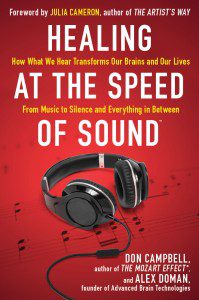 I’m delighted to have Don Campbell, bestselling author of The Mozart Effect®, and Alex Doman, an expert in the practical application of sound and listening as my guests today. Their new book, Healing at the Speed of Sound: How What We Hear Transforms Our Brains and Our Lives, From Music to Silence and Everything in Between (Hudson Street Press), shows how we can use music?and silence?to become more efficient, and productive, relaxed, and healthy.
I’m delighted to have Don Campbell, bestselling author of The Mozart Effect®, and Alex Doman, an expert in the practical application of sound and listening as my guests today. Their new book, Healing at the Speed of Sound: How What We Hear Transforms Our Brains and Our Lives, From Music to Silence and Everything in Between (Hudson Street Press), shows how we can use music?and silence?to become more efficient, and productive, relaxed, and healthy.
How Our Earliest Development of Hearing and Speech Leads to a Lifetime of Sound
Taken from Healing at the Speed of Sound and used with permission © 2011
By Don Campbell and Alex Doman
Let’s take a closer look at the ways in which your physical, emotional, and intellectual development have been profoundly affected by sound’s physical properties— rhythm, pitch, and frequency or vibration— from your earliest days of life. Your manner of speaking, of walking, of interacting with others socially and emotionally— your ability to really hear what others are saying to you, to focus on tasks, and to stick to your goals until you have achieved them—all of these aspects of your personality and demeanor have been shaped to some degree by your interactions with sound. In a very real sense, throughout childhood, adolescence, and adulthood, sound has made you what you are today.
In recent years, a wave of new research, powered by new technology and diagnostic techniques, has provided us with fascinating glimpses of the specific ways in which this process works. Studies conducted around the world have demonstrated how sound’s energy shapes the brain’s development before birth; how its rhythms regulate our physical movements; how pitch, tone, and musical structure can fine- tune the mind and sharpen listening skills; how music making improves students’ test scores and communication skills; and how professional musicians’ brains actually differ in structure from the brains of non musicians. The conclusion reached by British and American scientists at the “Musical Brain” conference at London’s Royal Institution in 2001— a gathering marking the culmination of the 1990s’ “Decade of the Brain”—was that, far more than just a cultural phenomenon, music is “a biological fact of human life” intimately involved in our physiological functions.1 In this chapter, we will examine that research and consider how these findings can improve your life and the growth and development of those around you.
Overture: The music of your life began with a heartbeat. From the moment you acquired the ability to process sound in your mother’s womb— sometime during the second trimester of your development— the steady thump of her beating heart permeated your developing body and brain, imprinting its rhythm over and over, millions of times before your birth. Other sounds washed around you too— the loud, constant rush of blood flowing through the placenta, the gurgling sounds of digestion, the comforting vibration of your mother’s voice resonating through her body and yours.
From outside, the novel sound patterns of human laughter, conversation, traffic, machinery, and music permeated the wall of the womb and were transmitted to your ears through the amniotic fluid, though their frequencies were filtered and you, immersed in liquid, heard only muffled sounds. Penn State neuroscientist Rick Gilmore suggests that, as a result, the voices of your family members probably sounded like “the squawk of the muted brass instrument that depicts grown- ups talking in the animated Peanuts cartoons.” Nevertheless, “there is a lot of information in that filtered
and muted sound stream.”
As parents have long known, the fetus responds easily and frequently to sound in the environment, particularly during the final trimester. Pregnant musicians have reported feeling their unborn children kick in time to the music they play— sometimes even stopping and starting as the music stops and resumes. 5 Writer and radio host Al Letson tells of the nights in bed when he and his unborn daughter exchanged kicks and gentle pokes through the wall of her sleeping mother’s stomach— a rhythmic communication that laid the groundwork for an intense connection between them once his daughter was born. 6 For decades, scientists have routinely documented such fetal responses to loud sounds, in the form of startled responses and increased heart rate. 7 The fact that babies can hear outside sounds is indisputable. The more interesting question is whether the fetus understands these sounds in any sense. When you heard music or your mother’s voice, did you actively listen, and did those sounds carry meaning for you? Did they affect the development of your brain and body? And following birth were you able to remember them?
In fact, the depth and range of the fetus’s sensation is far greater than most of us realize. The developing brain perceives through contrast. A sudden change in sensory stimulation— the sound of laughter, say, mixing with the background sounds of your mother’s body— told your fetal brain that something new had happened. When this stimulation entered your auditory cortex, your brain responded with a sharp “What’s that?”— and went to work trying to connect the sound with past experiences and fit it into a developing pattern of understanding. Your brain was not simply registering sound, in other words, but was actively trying to make sense of it. 8 And as it fit together the pieces of the sound puzzle of the world outside, these patterns were mirrored in its own development. With each new sound pattern, new neurological pathways were carved, like grooves in a vinyl record.
Researchers have traced this process in a number of ways. Their studies show that the fetus not only senses sound from outside the mother’s body, but it differentiates between novel and familiar sounds, responding physically to new sounds while growing indifferent or habituated to those that are repeated consistently. 9 This recognition of the familiar, in which the fetal brain stops responding to an often- repeated sound with “What’s that?” represents the first form of learning.
The fetus is capable of remembering what it has learned as well. In one well- known study, researchers directed a quiet vibratory sound toward the mother’s abdomen, followed by a loud sound. The first time this was done, the fetus did not respond to the gentle stimulus, but did respond to the succeeding jarring sound. When the sequence was repeated, however, the fetus responded to the quiet sound, as though remembering the sound pattern and anticipating the loud stimulus to follow.
Your brain’s search for patterns and its sensitivity to sound contrasts allowed you to learn and remember the cadence and inflections of your mother’s voice before you ever left the womb. While still in utero, you could distinguish between her language and a foreign tongue, probably due to the differences in rhythm. The downbeat in spoken language is “like an edge finder, or the boundary of rhythm” for the fetus, explains Ann Senghas, a psychologist at Barnard College, in New York. At the same time, as studies have shown, your neurons learned to prioritize some sounds. When a sound became important— when your mother’s singing to you during pregnancy, for instance, increased the levels of positive hormones in her blood, which in turn nourished you— your cells’ response to that tone increased. Your brain learned to respond strongly to her singing as a source of pleasure13— the beginning of the lovely mother- infant bonding process that continued after birth, and one reason why your mother’s lullabies could so effectively soothe you and help you drift toward sleep.
Developing human brains seem particularly attuned to music— even more than to language— no doubt due to its structural complexity and interesting patterns. A song does not have to be beautiful, or even directed at the fetus, to be remembered after the baby is born. Infants often recognize and respond to the theme songs of television shows their mothers watched most while pregnant, for example. Just as certain foods are more nourishing than others, however, even if all types provide calories, high quality classical, world, and other complex instrumental and vocal selections provide broader and more varied stimulation to the fetus than the typical theme song or simple pop tune.
****************************
Check out Healing at the Speed of Sound to learn how being a aware of how sound affects you can help you improve many areas of your life.
Please leave comments under my posts so we can stay connected.

